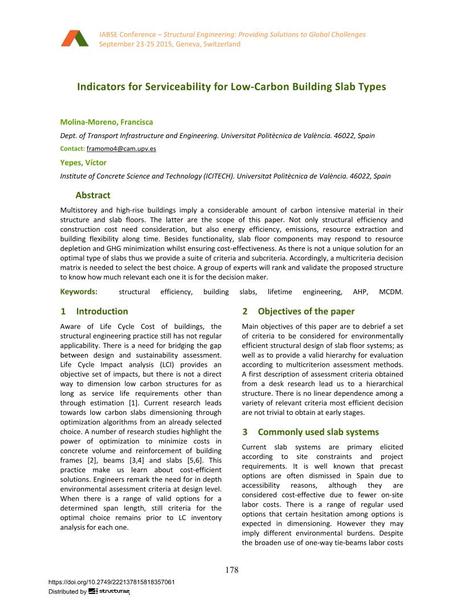Indicators for Serviceability for Low-Carbon Building Slab Types

|
|
|||||||||||
Bibliographic Details
| Author(s): |
Francisca Molina-Moreno
(Dept. of Transport Infrastructure and Engineering. Universitat Politècnica de València. 46022, Spain)
Víctor Yepes-Piqueras (Institute of Concrete Science and Technology (ICITECH). Universitat Politècnica de València. 46022, Spain) |
||||
|---|---|---|---|---|---|
| Medium: | conference paper | ||||
| Language(s): | English | ||||
| Conference: | IABSE Conference: Structural Engineering: Providing Solutions to Global Challenges, Geneva, Switzerland, September 2015 | ||||
| Published in: | IABSE Conference Geneva 2015 | ||||
|
|||||
| Page(s): | 178-185 | ||||
| Total no. of pages: | 8 | ||||
| Year: | 2015 | ||||
| DOI: | 10.2749/222137815818357061 | ||||
| Abstract: |
Multistorey and high-rise buildings imply a considerable amount of carbon intensive material in their structure and slab floors. The latter are the scope of this paper. Not only structural efficiency and construction cost need consideration, but also energy efficiency, emissions, resource extraction and building flexibility along time. Besides functionality, slab floor components may respond to resource depletion and GHG minimization whilst ensuring cost-effectiveness. As there is not a unique solution for an optimal type of slabs thus we provide a suite of criteria and subcriteria. Accordingly, a multicriteria decision matrix is needed to select the best choice. A group of experts will rank and validate the proposed structure to know how much relevant each one it is for the decision maker. |
||||
| Keywords: |
structural efficiency building slabs lifetime engineering AHP MCDM
|
||||
